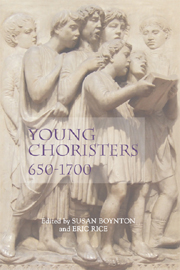Book contents
- Frontmatter
- Contents
- List of Illustrations
- List of Musical Examples
- Acknowledgements
- Dedication
- Introduction: Performance and Premodern Childhood
- 1 The Boy Singers of the Roman Schola Cantorum
- 2 Boy Singers in Medieval Monasteries and Cathedrals
- 3 The Musical Education of Young Girls in Medieval English Nunneries
- 4 Choirboys in Early English Religious Drama
- 5 From Mozos de coro towards Seises: Boys in the Musical Life of Seville Cathedral in the Fifteenth and Sixteenth Centuries
- 6 The Seeds of Medieval Music: Choirboys and Musical Training in a Late-Medieval Maîtrise
- 7 Choirboys in Cambrai in the Fifteenth Century
- 8 Choirboys and Vicaires at the Maîtrise of Cambrai: A Socio-anthropological Study (1550–1670)
- 9 Choirboys, Memorial Endowments and Education at Aachen's Marienkirche
- 10 Thomas Mulliner: An Apprentice of John Heywood?
- 11 Cantando tutte insieme: Training Girl Singers in Early Modern Sienese Convents
- 12 Choirboys in Early Modern Rome
- General Bibliography
- Index
12 - Choirboys in Early Modern Rome
Published online by Cambridge University Press: 12 September 2012
- Frontmatter
- Contents
- List of Illustrations
- List of Musical Examples
- Acknowledgements
- Dedication
- Introduction: Performance and Premodern Childhood
- 1 The Boy Singers of the Roman Schola Cantorum
- 2 Boy Singers in Medieval Monasteries and Cathedrals
- 3 The Musical Education of Young Girls in Medieval English Nunneries
- 4 Choirboys in Early English Religious Drama
- 5 From Mozos de coro towards Seises: Boys in the Musical Life of Seville Cathedral in the Fifteenth and Sixteenth Centuries
- 6 The Seeds of Medieval Music: Choirboys and Musical Training in a Late-Medieval Maîtrise
- 7 Choirboys in Cambrai in the Fifteenth Century
- 8 Choirboys and Vicaires at the Maîtrise of Cambrai: A Socio-anthropological Study (1550–1670)
- 9 Choirboys, Memorial Endowments and Education at Aachen's Marienkirche
- 10 Thomas Mulliner: An Apprentice of John Heywood?
- 11 Cantando tutte insieme: Training Girl Singers in Early Modern Sienese Convents
- 12 Choirboys in Early Modern Rome
- General Bibliography
- Index
Summary
AS in other cities, choirboys played an essential role in the soundscape of early modern Rome. With the exception of the Cappella Pontificia, all institutions with regular choirs made use of a small number of boys. Their musical training, which was entrusted to the maestro di cappella, played an important role in the transmission of repertory and in the development of Roman styles of composition; many of these boys in turn became singers and maestri in the city's institutions. The instruction of the Nanino brothers, Giovanni Maria and Giovanni Bernardino, who both served as maestri at San Luigi dei Francesi as well as at other churches, was particularly well known, and some of their teaching materials survive. This chapter reviews the evidence for the use of boys in performances of sacred music during the sixteenth and early seventeenth centuries, based on the archival records of various institutions and on notarial agreements between parents and institutions or maestri. It also surveys the repertory they would have sung and the methods used in their musical training. The use of boys' voices was not confined to singing polyphony and chant in major churches; they also sang the popular laude spirituali at devotional gatherings, performed in sacre rappresentazioni, and were regularly heard in Christian doctrine classes.
ROME’S CHORAL INSTITUTIONS
AT the beginning of the sixteenth century, Rome had relatively few permanent choirs other than the Cappella Pontificia, and comparatively little is known about them. Christopher Reynolds, who has studied the choir of St. Peter’s Basilica prior to its refoundation as the Cappella Giulia by Pope Julius ii in 1513, sees the reign of Pope Nicholas v (reigned 1447–55) as a turning point in the development of polyphonic music and notes the earliest surviving reference to boys at the basilica in 1447, when the singer Rubino twice collected extra wages to cover the expenses of two boys.
- Type
- Chapter
- Information
- Young Choristers, 650–1700 , pp. 216 - 240Publisher: Boydell & BrewerPrint publication year: 2008

